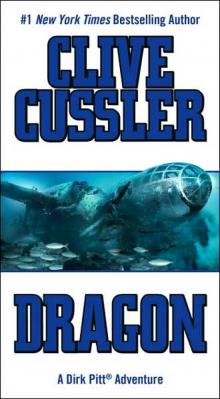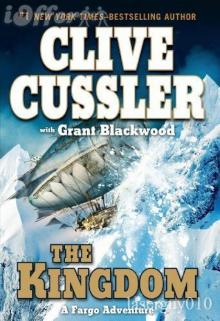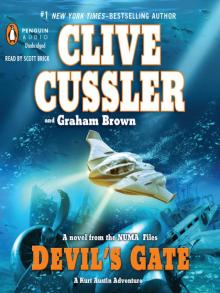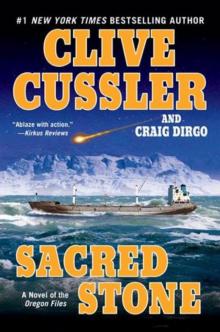- Home
- Clive Cussler
Atlantis Found
Atlantis Found Read online
Atlantis Found By Clive Cussler
IMPACT
7120 B.C.
What is now Hudson Bay, Canada
The intruder came from beyond. A nebulous celestial body as old as the universe itself, it had been born in a vast cloud of ice, rocks, dust, and gas when the outer planets of the solar system were formed 4.6 billion years ago. Soon after its scattered particles had frozen into a solid mass one mile in diameter, it began streaking silently through the emptiness of space on an orbital voyage that carried it around a distant sun and halfway to the nearest stars again, a journey lasting many thousands of years from start to finish.
The comet's core, or nucleus, was a conglomeration of frozen water, carbon monoxide, methane gas, and jagged blocks of metallic rocks. It might accurately be described as a dirty snowball hurled through space by the hand of God. But as it whirled past the sun and swung around on its return path beyond the outer reaches of the solar system, the solar radiation reacted with its nucleus and a metamorphosis took place. The ugly duckling soon became a thing of beauty.
As it began to absorb the sun's heat and ultraviolet light, a long comma formed that slowly grew into an enormous luminous blue tail that curved and stretched out behind the nucleus for a distance of 90 million miles. A shorter, white dust tail more than one million miles wide also materialized and curled out on the sides of the larger tail like the fins of a fish.
Each time the comet passed the sun, it lost more of its ice and its nucleus diminished. Eventually, in another 200 million years, it would lose all its ice and break up into a cloud of dust and become a series of small meteorites. This comet, however, would never orbit outside the solar system or pass around the sun again. It would not be allowed a slow, cold death far out in the blackness of space. Within a few short minutes, its life would be snuffed out. But on this, its latest orbit, the comet passed within 900,000
miles of Jupiter, whose great gravitational force veered it off on a collision course with the third planet from the sun, a planet its inhabitants called Earth.
Plunging into Earth's atmosphere at 130,000 miles an hour on a forty-five-degree angle, its speed ever-increasing with the gravitational pull, the comet created a brilliant luminescent bow shock as its ten-mile-wide, four-billion-ton mass began to break into fragments due to friction from its great speed.
Seven seconds later, the misshapen comet, having become a blinding fireball, smashed onto Earth's surface with horrendous effect. The immediate result from the explosive release of kinetic energy upon impact was to gouge out a massive cavity twice the size of the island of Hawaii as it vaporized and displaced a gigantic volume of water and soil.
The entire earth staggered from the seismic shock of a 12.0 earthquake. Millions of tons of water, sediment, and debris burst upward, thrown through the hole in the atmosphere above the impact site and into the stratosphere, along with a great spray of pulverized, fiery rock that was ejected into suborbital trajectories before raining back to earth as blazing meteorites. Firestorms destroyed forests throughout the world. Volcanoes that had been dormant for thousands of years suddenly erupted, sending oceans of molten lava spreading over millions of square miles, blanketing the ground a thousand or more feet deep.
So much smoke and debris were hurled into the atmosphere and later blown into every corner of the land by terrible winds that they blocked out the sun for nearly a year, sending temperatures plunging below freezing, and shrouding Earth in darkness. Climatic change in every corner of the world came with incredible suddenness. Temperatures at vast ice fields and northern glaciers rose until they reached between ninety and a hundred degrees Fahrenheit, causing a rapid meltdown. Animals accustomed to tropical and temperate zones became extinct overnight. Many, such as the woolly mammoths, turned to ice where they stood in the warmth of summer, grasses and flowers still undigested in their stomachs.
Trees, along with their leaves and fruit, were quick-frozen. For days, fish that were hurled upward from the impact fell from the blackened skies.
Waves five to ten miles in height were thrown against the continents, surging over shorelines with a destructive power that was awesome in magnitude. Water swept over low coastal plains and swept hundreds of miles inland, destroying everything in its path. Endless quantities of debris and sediment from the ocean floors were spread over low landmasses. Only when the great surge smashed against the base of mountains did it curl under and begin a slow retreat, but not before changing the course of rivers, filling land basins with seas where none existed before and turning large lakes into deserts.
The chain reaction seemed endless.
With a low rumble that grew to the roar of continuous thunder, the mountains began to sway like palm trees under a light breeze as avalanches swept down their sides. Deserts and grassy plains undulated as the onslaught from the oceans reared up and struck inland again. The shock from the comet's impact had caused a sudden and massive displacement in Earth's thin crust. The outer shell, less than forty miles thick, and the mantle that lay over the hot fluid core buckled and twisted, shifting crustal layers like the skin of a grapefruit that had been surgically removed and then neatly replaced so it could move around the core of fruit inside. As if controlled by an unseen hand, the entire crust then moved as a unit.
Entire continents were shoved around to new locations. Hills were thrust up to become mountains.
Islands throughout the Pacific Ocean vanished, while others emerged for the first time. Antarctica, previously west of Chile, slid over two thousand miles to the south, where it was quickly buried under growing sheets of ice. The vast ice pack that once floated in the Indian Ocean west of Australia now found itself in a temperate zone and rapidly began to melt. The same occurred with the former North Pole, which had spread throughout northern Canada. The new pole soon began to produce a thick ice mass in the middle of what once had been open ocean.
The destruction was relentless. The convulsions and holocaust went on as if they would never stop.
The movement of the Earth's thin outer shell piled cataclysm upon cataclysm. The abrupt melting of the former ice packs, combined with glaciers covering the continents that had suddenly shifted into or near tropical zones, caused the seas to rise four hundred feet, drowning the already destroyed land that had been overwhelmed by tidal waves from the comet's impact. In the time span of a single day, Britain, connected to the rest of the European continent by a dry plain, was now an island, while a desert that became known as the Persian Gulf was abruptly inundated. The Nile River, having flowed into a vast fertile valley and then on toward the great ocean to the west, now ended at what had suddenly become the Mediterranean Sea.
The last great ice age had ended in the geological blink of an eye.
The dramatic change in the oceans and their circulation around the world also caused the poles to shift, drastically disturbing the earth's rotational balance. Earth's axis was temporarily thrown off by two degrees, as the North and South Poles were displaced to new geographical locations, altering the centrifugal acceleration around the outer surface of the sphere. Because they were fluid, the seas adapted before the earth made another three revolutions. But the landmass could not react as quickly.
Earthquakes went on for months.
Savage storms with brutal winds swirled around the earth, shredding and disintegrating everything that stood on the ground for the next eighteen years before the poles stopped wobbling and settled into their new rotational axis. In time, sea levels stabilized, permitting new shorelines to form as bizarre climatic conditions continued to moderate. Changes became permanent. The time sequence between night and day changed as the number of days in a year decreased by two. The earth's magnetic field was also affected and moved northwest over a hundred
miles.
Hundreds, perhaps thousands, of different species of animals and fish became instantly extinct. In the Americas, the one-humped camel, the mammoth, an ice age horse, and the giant sloth all disappeared.
Gone also were the saber-toothed tiger, huge birds with twenty-five foot wingspans and many other animals that weighed a hundred or more pounds, most dying by asphyxiation from the smoke and volcanic gases.
Nor did the vegetation on land escape the apocalypse. Plant life not turned to ashes by the holocaust died for lack of sunlight, along with the algae in the seas. In the end, over 85 percent of all life on Earth would die from floods, fires, storms, avalanches, poison from the atmosphere, and eventual starvation.
Human societies, many quite advanced, and a myriad of emerging cultures on the threshold of a progressive golden age were annihilated in a single horrendous day and night. Millions of Earth's men, women, and children died horribly. All vestiges of emerging civilizations were gone, and the few pathetic survivors were left with nothing but dim memories of the past. The coffin had been closed on the greatest uninterrupted advance of mankind, a ten-thousand-year journey from the simple Cro-Magnon man to kings, architects, stonemasons, artists, and warriors. Their works and their mortal remains were buried deep beneath new seas, leaving few physical examples and fragments of an ancient advanced culture.
Entire nations and cities that had stood only a few hours before vanished without a trace. The cataclysm of such magnitude left almost no evidence of any prior transcendent civilizations.
Of the shockingly low number of humans who survived, almost all lived in the higher altitudes of mountain ranges and were able to hide in caves to escape the furies of the turbulence. Unlike the more advanced Bronze Age peoples who tended to cluster and build on lowlying plains near rivers and ocean shorelines, the inhabitants of the mountains were Stone Age nomads. It was as though the cream of the crop, the Leonardo da Vincis, the Picassos, and the Einsteins of their era had evaporated into nothingness, abruptly leaving the world to be taken over by primitive nomadic hunters, a phenomenon similar to what happened to the glory of Greece and Rome after it was cast aside in favor of centuries of ignorance and creative lethargy. A neolithic dark age shrouded the grave of the highly cultured civilizations that once existed in the world, a dark age that would last for two thousand years. Slowly, very slowly, did mankind finally walk from the dark and begin building and creating cities and civilizations again in Mesopotamia and Egypt.
Pitifully few of the gifted builders and creative thinkers of the lost cultures survived to reach high ground. Realizing their civilization was lost, never to rise again, they began a centuries-long quest to erect the mysterious megaliths and dolmens of huge upright stones found across Europe, Asia, the Pacific Islands, and into the lower Americas. Long after the memory of their shining legacy had dimmed and become little more than myth, their monuments commemorating the frightful destruction and loss of life still acted as warnings of the next cataclysm to future generations. But within a millennium, their descendants slowly forgot the old ways and assimilated with the nomadic tribes and ceased to exist as a race of advanced people.
For hundreds of years after the convulsion, humans were afraid to venture down from the mountains and re-inhabit the lower lands and coastal shorelines. The technically superior seafaring nations were but vague thoughts of a distant past. Ship construction and sailing techniques were lost and had to be reinvented by later generations whose more accomplished ancestors were revered simply as gods.
All this death and devastation was caused by a hunk of dirty ice no larger than a small farm town in Iowa. The comet had wreaked its unholy havoc, mercilessly, viciously. The earth had not been ravaged with such vehemence since a meteor had struck 65 million years earlier in a catastrophe that had exterminated the dinosaurs.
For thousands of years after the impact, comets were associated with superstitions of catastrophic events and considered omens of future tragedies. They were blamed for everything from wars and pestilence to death and destruction. Not until recent history were comets considered nature's wonders, like the splendor of a rainbow or clouds painted gold by a setting sun.
The biblical flood and a host of other calamity legends all had ties to this one tragedy. The ancient civilizations of Olmecs, Mayans, and Aztecs of Central America had many traditions relating to an ancient cataclysmic event. The Indian tribes throughout the United States passed down stories of waters flooding over their lands. The Chinese, the Polynesians, and Africans all spoke of a cataclysm that decimated their ancestors.
But the legend that was spawned and that flourished throughout the centuries, the one that provoked the most mystery and intrigue, was that of the lost continent and civilization of Atlantis.
GHOST SHIP
September 30, 1858
Stefansson Bay, Antarctica
Roxanna Mender knew that if she stopped walking she would die. She was near complete exhaustion and moving on willpower alone. The temperature was well below zero, but it was the windchill from the frigid teeth of the ice gale that was biting through her skin. The deadly drowsiness gently slipping over her was slowly draining her will to live. She moved forward, one foot groping ahead of the other, stumbling when caught off balance by a sudden break in the ice field. Her breath came in the rapid, rasping panting of a mountain climber struggling toward a peak in the Himalayas without oxygen equipment.
Her vision was nonexistent as the icy windblown particles swirled in front of her face, protected by a thick woolen scarf wrapped inside her fur-lined parka. Though she only squinted between the layers of the scarf every other minute, her eyes were sore and reddened from the onslaught of the tiny granules.
Frustration gripped Roxanna when she looked up and saw the dazzling blue sky and brilliant sun above the storm. Blinding ice storms under clear skies were not an uncommon phenomenon in Antarctica.
Surprisingly, snow rarely falls in the South Polar region. It is so incredibly cold that the atmosphere cannot contain water vapor, so any snowfall is minimal. Not more than five inches falls over the continent in the course of a year. Some of the snow that is already on the ground is actually several thousand years old. The harsh sun strikes the white ice on an oblique angle and its heat is reflected back into space, contributing largely to the extraordinarily cold temperatures.
Roxanna was fortunate. The cold did not penetrate her clothing. Rather than wearing European cold-weather garb, she was dressed in clothing her husband had acquired while trading with Eskimos during his earlier whaling expeditions in the Arctic. Her inner clothing consisted of a tunic, short knee-length pants, and a socklike boot made with soft fur worn against her feet. Separate outerwear protected against extreme cold. The parka was loose-fitting to allow body heat to circulate and escape without the problem of sweat buildup. It was made from wolf fur, while the pants came from a caribou.
The boots stood high and were worn over the socks, with the fur inward.
Her greatest physical danger lay in breaking an ankle or leg on the uneven surface, and if she somehow survived, there was the threat of frostbite. Though her body was protected, it was her face that worried her. At the least tingle on either her cheek or nose, she vigorously rubbed the skin to restart circulation.
She had already watched six of her husband's crew develop frostbite, two of them losing toes and one his ears.
Thankfully, the icy gale began to die away and lose its violence, and her progress became easier than it had been for the past hour she had been wandering lost. The howling wind faded from her ears, and she could hear the squeak of the ice crystals beneath her feet.
She reached a hill about fifteen feet high from base to ridge formed by the restless sea ice grinding and forcing the floe upward into what was called a hummock. Most formed an uneven surface, but this one was weathered until its sides were smooth. Falling to her hands and knees, she clawed her way upward, sliding back two feet for every three she gained.
> The exertion took what little strength Roxanna had left. Without knowing how, or remembering the struggle, she pulled herself onto the ridge of the hummock half-dead from exhaustion, heart pounding, breath coming in labored gasps. She did not know how long she lay there, but she was thankful to rest her eyes from the ice-plagued wind. After a few minutes, when her heart slowed and her breath began to come evenly, Roxanna cursed herself for the predicament she had foolishly caused. Time had no reference. Without a watch, she had no idea how many hours had passed since she walked from her husband's whaling ship, the Paloverde.
Nearly six months earlier, the ship had become locked in the pack ice, and to endure the boredom she had begun taking daily hikes, keeping within easy view of the ship and its crew, who kept an eye on her.
That morning the skies had dawned crystal clear when she left the ship, but they soon turned dark and vanished when the ice storm swept over the ice. Within minutes, the ship had disappeared and Roxanna found herself wandering lost on the ice pack.
Traditionally, most whalers never sailed with women aboard. But many wives refused to sit at home for the three to four years their husbands were gone. Roxanna Mender was not about to spend thousands of lonely hours alone. She was a hardy woman, though petite, barely reaching five feet in height and weighing less than a hundred pounds. With her light brown eyes and ready smile, she was a pretty woman who seldom complained of the hardship and boredom and who rarely became seasick. In her cramped cabin she had already given birth to a baby boy, whom she had named Samuel. And though she had yet to tell her husband, she was about two months pregnant with the next baby. She had found acceptance aboard ship with the crew, taught several to read, written letters home to their wives and families, and acted as nurse whenever there was an injury or sickness on board.
The Paloverde was one of the fleet of whalers that sailed from San Francisco on the nation's west coast. She was a stout ship, especially constructed for polar operations during the whaling season. With a length of 132 feet, a beam of 30 feet, and a draft of 17 feet, her tonnage was close to 330. Her dimensions allowed for a large cargo of whale oil and accommodations for a lame crew of officers and men for voyages that could last as long as three years. Her pine keel, timbers, and beams were cut from the forests of the Sierra Nevada Mountains. Once they were positioned, the three-inch planking was laid on and fastened by trunnels, a wooden nail usually cut from oak.

 Deep Six
Deep Six Odessa Sea
Odessa Sea Flood Tide
Flood Tide Valhalla Rising
Valhalla Rising Thriller 2
Thriller 2 The Tombs
The Tombs Lost Empire
Lost Empire The Gray Ghost
The Gray Ghost The Eye of Heaven
The Eye of Heaven Polar Shift
Polar Shift The Kingdom
The Kingdom Trojan Odyssey
Trojan Odyssey Shadow Tyrants
Shadow Tyrants Nighthawk
Nighthawk Blue Gold
Blue Gold Serpent
Serpent Lost City
Lost City The Gangster
The Gangster White Death
White Death Inca Gold
Inca Gold The Mayan Secrets
The Mayan Secrets The Pharaoh's Secret
The Pharaoh's Secret The Emperor's Revenge
The Emperor's Revenge Corsair
Corsair Sacred Stone
Sacred Stone The Silent Sea
The Silent Sea The Rising Sea
The Rising Sea Black Wind
Black Wind Fast Ice
Fast Ice Ghost Ship
Ghost Ship Marauder
Marauder The Thief
The Thief Medusa
Medusa Typhoon Fury
Typhoon Fury Journey of the Pharaohs
Journey of the Pharaohs The Navigator
The Navigator The Saboteurs
The Saboteurs Crescent Dawn
Crescent Dawn Skeleton Coast
Skeleton Coast Wrath of Poseidon
Wrath of Poseidon The Mediterranean Caper
The Mediterranean Caper The Romanov Ransom
The Romanov Ransom Treasure
Treasure The Race
The Race The Bootlegger
The Bootlegger Spartan Gold
Spartan Gold Havana Storm
Havana Storm Dragon
Dragon Piranha
Piranha Poseidon's Arrow
Poseidon's Arrow The Cutthroat
The Cutthroat Atlantis Found
Atlantis Found The Jungle
The Jungle The Oracle
The Oracle Treasure / Dragon / Sahara: Clive Cussler Gift Set
Treasure / Dragon / Sahara: Clive Cussler Gift Set Clive Cussler and Dirk Pitt Revealed
Clive Cussler and Dirk Pitt Revealed The Sea Hunters
The Sea Hunters Pirate
Pirate The Striker
The Striker Plague Ship
Plague Ship The Wrecker
The Wrecker Iceberg
Iceberg The Chase
The Chase The Spy
The Spy Golden Buddha
Golden Buddha The Titanic Secret
The Titanic Secret Zero Hour
Zero Hour Fire Ice
Fire Ice Dark Watch
Dark Watch The Storm
The Storm The Assassin
The Assassin Vixen 03
Vixen 03 Arctic Drift
Arctic Drift Night Probe!
Night Probe! Cyclops
Cyclops Medusa nf-8
Medusa nf-8 Shock Wave dp-13
Shock Wave dp-13 Marauder (The Oregon Files)
Marauder (The Oregon Files) Lost Empire fa-2
Lost Empire fa-2 Arctic Drift dp-20
Arctic Drift dp-20 Dirk Pitt 22 - Poseidon's Arrow
Dirk Pitt 22 - Poseidon's Arrow Treasure of Khan dp-19
Treasure of Khan dp-19 Dark Watch of-3
Dark Watch of-3 Devil's Gate
Devil's Gate The Sea Hunters II: More True Adventures with Famous Shipwrecks
The Sea Hunters II: More True Adventures with Famous Shipwrecks Flood Tide dp-14
Flood Tide dp-14 The Mediterranean Caper dp-2
The Mediterranean Caper dp-2 Iceberg dp-3
Iceberg dp-3 Sahara dpa-11
Sahara dpa-11 Pacific Vortex! dp-1
Pacific Vortex! dp-1 Deep Six dp-7
Deep Six dp-7 Dragon dp-10
Dragon dp-10 Serpent nf-1
Serpent nf-1 Havana Storm (Dirk Pitt Adventure)
Havana Storm (Dirk Pitt Adventure) Zero Hour nf-11
Zero Hour nf-11 The Storm nf-10
The Storm nf-10 The Thief ib-5
The Thief ib-5 Lost City nf-5
Lost City nf-5 The Mayan Secrets fa-5
The Mayan Secrets fa-5 White Death nf-4
White Death nf-4 The Kingdom fa-3
The Kingdom fa-3 Devil's Gate nf-9
Devil's Gate nf-9 Poseidon's Arrow dp-22
Poseidon's Arrow dp-22 Raise the Titanic dp-4
Raise the Titanic dp-4 Shadow Tyrants--Clive Cussler
Shadow Tyrants--Clive Cussler Sacred Stone of-2
Sacred Stone of-2 Skeleton Coast tof-4
Skeleton Coast tof-4 Mirage tof-9
Mirage tof-9 The Jungle of-8
The Jungle of-8 The Emperor's Revenge (The Oregon Files)
The Emperor's Revenge (The Oregon Files) Golden Buddha of-1
Golden Buddha of-1 Blue & Gold
Blue & Gold The Tombs fa-4
The Tombs fa-4 Inca Gold dp-12
Inca Gold dp-12 Treasure dp-9
Treasure dp-9 Atlantis Found dp-15
Atlantis Found dp-15 Black Wind dp-18
Black Wind dp-18 the Silent Sea (2010) tof-7
the Silent Sea (2010) tof-7 The Wrecker ib-2
The Wrecker ib-2 Fire Ice nf-3
Fire Ice nf-3 The Chase ib-1
The Chase ib-1 Sahara
Sahara The Striker ib-6
The Striker ib-6 Polar Shift nf-6
Polar Shift nf-6 The Race ib-4
The Race ib-4 Corsair of-6
Corsair of-6 Cyclops dp-8
Cyclops dp-8 The Navigator nf-7
The Navigator nf-7 Plague Ship tof-5
Plague Ship tof-5 Sea of Greed
Sea of Greed Vixen 03 dp-5
Vixen 03 dp-5 Thriller 2: Stories You Just Can't Put Down
Thriller 2: Stories You Just Can't Put Down